Groundwater Modeling with Process-Based and Data-Driven Approaches in the Context of Climate Change
Abstract
:1. Introduction
2. Materials and Methods
2.1. Process-Based Model
2.2. Data-Driven Model
- (1)
- Gap filling;
- (2)
- Trend and outlier analysis;
- (3)
- Autocorrelation and cross-correlation;
- (4)
- MLRA;
- (5)
- Residual analysis;
- (6)
- Validation and forecasting.
2.3. Process-Based and Data-Driven Models Combined
3. Results
3.1. Process-Based Models of the Empoli Aquifer System
3.1.1. Conceptual Model
- The chiefly confined lower aquifer layer consists of sandy gravels and gravels with an average thickness of approx. 7 m (maximum 14 m). The base of the aquifer is represented by the Pliocene substratum. This aquifer is separated from the upper aquifer by a clayey layer of variable thickness (average 7 m) and spatially discontinuous. Locally, where the clayey septum is not present, this aquifer level is hydraulically connected to the shallower one.
- The upper aquifer was reconstructed with continuity over the entire domain and represented the main aquifer in volumetric terms. It is composed of sand and gravel, often in mixed components; the grain size varies from predominantly gravelly sandy in the sectors facing the Arno River to a sandy loamy in the more distal areas. The average thickness of the aquifer is approx. 10 m, with varying values up to 20 m.
- Generally, a horizon defined in the reconstruction as an aquitard/aquiclude is above the most superficial aquifer, but its grain composition, typically consisting of clayey and sandy silts, is such that it does not impart a purely confined character to the most superficial aquifer.
3.1.2. Models Implementation
3.1.3. Models Calibration, Validation, and Output
3.1.4. Forecast Simulations
3.2. Data-Driven Model of the Brenta Aquifer System
3.2.1. Conceptual Model
3.2.2. Model Implementation and Validation
3.2.3. Forecasting Simulation
3.3. Combined Approach of Data-Driven and Process-Based Models for the Magra Lower-Valley Aquifer System
3.3.1. Conceptual Model
3.3.2. Process-Based and Data-Driven Models Implementation and Calibration
3.3.3. Forecasting Simulation
4. Discussion and Conclusions
Author Contributions
Funding
Data Availability Statement
Acknowledgments
Conflicts of Interest
References
- United Nations. The United Nations World Water Development Report 2022: Groundwater: Making the Invisible Visible; UNESCO: Paris, France, 2022; p. 225. ISBN 978-92-3-100507-7. [Google Scholar]
- Hiscock, K.M. Groundwater in the 21st century—meeting the challenges. In Sustaining Groundwater Resources: A Critical Element in the Global Water Crisis, in International Year of Planet Earth; Anthony, J., Jones, A., Eds.; Springer: Dordrecht, Netherlands, 2011; pp. 207–225. [Google Scholar] [CrossRef]
- Zhu, Y.; Balke, K.D. Groundwater protection: What can we learn from Germany? J. Zhejiang Univ. Sci. 2008, 9, 227–231. [Google Scholar] [CrossRef] [PubMed] [Green Version]
- Baoxiang, Z.; Fanhai, M. Delineation methods and application of groundwater source protection zone. In Proceedings of the Water Resource and Environmental Protection (ISWREP), 2011 International Symposium, (IEEE Conference Publications), Xi’an, China, 20–22 May 2011; Volume 1, pp. 66–69. [Google Scholar] [CrossRef]
- Martınez Navarrete, C.; Grima Olmedo, J.; Duran Valsero, J.J.; Gomez, J.D.; Luque Espinar, J.A.; de la Orden, G.J.A. Groundwater protection in Mediterranean countries after the European water framework directive. Environ. Geol. 2008, 54, 537–549. [Google Scholar] [CrossRef]
- WBCSD Facts and Trends–Water. World Business Council for Sustainable Development. Available online: https://www.wbcsd.org/Programs/Food-and-Nature/Water/Resources/Water-Facts-and-trends (accessed on 1 September 2022).
- Siebert, S.; Burke, J.; Faures, J.M.; Frenken, K.; Hoogeveen, J.; Döll, P.; Portmann, F.T. Groundwater use for irrigation—A global inventory. Hydrol. Earth Syst. Sci. 2010, 14, 1863–1880. [Google Scholar] [CrossRef] [Green Version]
- Wada, Y.; Van Beek, L.P.H.; Van Kempen, C.M.; Reckman, J.W.T.M.; Vasak, S.; Bierkens, M.F.P. Global depletion of groundwater resources. Geophys. Res. Lett. 2010, 37, L20402. [Google Scholar] [CrossRef] [Green Version]
- Rosegrant, M.W.; Cai, X.; Cline, S.A. World Water and Food to 2025: Dealing with Scarcity; International Food Policy Research Institute: Washington, DC, USA, 2002; p. 322. [Google Scholar]
- Milly, P.C.D.; Dunne, K.A.; Vecchia, A.V. Global pattern of trends in streamflow and water availability in a changing climate. Nature 2005, 438, 347–350. [Google Scholar] [CrossRef]
- Hirabayashi, Y.; Mahendran, R.; Koirala, S.; Konoshima, L.; Yamazaki, D.; Watanabe, S.; Kim, H.; Kanae, S. Global flood risk under climate change. Nat. Clim. Chang. 2013, 3, 816–821. [Google Scholar] [CrossRef]
- Chan, D.; Wu, Q. Significant anthropogenic-induced changes of climate classes since 1950. Sci. Rep. 2015, 5, 13487. [Google Scholar] [CrossRef] [Green Version]
- Turco, M.; Palazzi, E.; von Hardenberg, J.; Provenzale, A. Observed climate change hotspots. Geophys. Res. Lett. 2015, 42, 3521–3528. [Google Scholar] [CrossRef]
- Tollefson, J. IPCC climate report: Earth is warmer than it’s been in 125,000 years. Nature 2021, 596, 171–172. [Google Scholar] [CrossRef]
- Taylor, R.G.; Scanlon, B.; Döll, P.; Rodell, M.; Van Beek, R.; Wada, Y.; Longuevergne, L.; Leblanc, M.; Famiglietti, J.S.; Edmunds, M.; et al. Ground water and climate change. Nat. Clim. Chang. 2013, 3, 322–329. [Google Scholar] [CrossRef] [Green Version]
- Ohba, M.; Arai, R.; Sato, T.; Imamura, M.; Toyoda, Y. Projected future changes in water availability and dry spells in Japan: Dynamic and thermodynamic climate impacts. Weather. Clim. Extremes 2022, 38, 100523. [Google Scholar] [CrossRef]
- Fan, Y. Groundwater. How much and how old? News Views. Nat. Geosci. 2015, 9, 93–94. [Google Scholar] [CrossRef]
- Doveri, M.; Menichini, M.; Scozzari, A. Protection of groundwater resources: Worldwide regulations, scientific approaches and case study. In The Handbook of Environmental Chemistry: Threats to the Quality of Groundwater Resources: Prevention and Control; Scozzari, A., Dotsika, E., Eds.; Springer-Verlag: Berlin/Heidelberg, Germany, 2016; Volume 40, pp. 13–30. [Google Scholar]
- Anderson, M.P.; Woessner, W.W.; Hunt, R.J. Applied Groundwater Modeling: Simulation of Flow and Advective Transport; Academic Press: Amsterdam, The Netherlands, 2015; p. 564. [Google Scholar]
- Krešic´, N.; Mikszewski, A. Hydrogeological Conceptual Site Model: Data Analysis and Visualization; CRC Press: Boca Raton, FL, USA, 2013. [Google Scholar]
- Reilly, T.E.; Harbaugh, A.W. Guidelines for Evaluating Ground-Water Flow Models; U.S. Geological Survey Scientific Investigations Report: Reston, VA, USA, 2004; Volume 5038, p. 30. [Google Scholar]
- Grodzka-Łukaszewska, M.; Nawalany, M.; Zijl, W. A Velocity-Oriented Approach for Modflow. Transp. Porous Media 2017, 119, 373–390. [Google Scholar] [CrossRef] [Green Version]
- Ginn, T.R.; Cushman, J.H. Inverse methods for subsurface flow: A critical review of stochastic techniques. Stoch. Hydrol. Hydraul. 1990, 4, 1–26. [Google Scholar] [CrossRef]
- Shapiro, A.M.; Day-Lewis, F.D. Reframing groundwater hydrology as a data-driven science. Groundwater 2022, 60, 455–456. [Google Scholar] [CrossRef]
- Curtis, Z.K.; Li, S.-G.; Liao, H.-S.; Lusch, D. Data-Driven Approach for Analyzing Hydrogeology and Groundwater Quality Across Multiple Scales. Groundwater 2017, 56, 377–398. [Google Scholar] [CrossRef] [PubMed]
- Xu, T.; Valocchi, A.J. Data-driven methods to improve baseflow prediction of a regional groundwater model. Comput. Geosci. 2015, 85, 124–136. [Google Scholar] [CrossRef] [Green Version]
- Bakker, M.; Maas, K.; Schaars, F.; von Asmuth, J.R. Analytic modeling of groundwater dynamics with an approximate impulse response function for areal recharge. Adv. Water Resour. 2007, 30, 493–504. [Google Scholar] [CrossRef]
- Sun, J.; Hu, L.; Li, D.; Sun, K.; Yang, Z. Data-driven models for accurate groundwater level prediction and their practical significance in groundwater management. J. Hydrol. 2022, 608, 127630. [Google Scholar] [CrossRef]
- Gusyev, M.; Haitjema, H.; Carlson, C.; Gonzalez, M. Use of Nested Flow Models and Interpolation Techniques for Science-Based Management of the Sheyenne National Grassland, North Dakota, USA. Groundwater 2012, 51, 414–420. [Google Scholar] [CrossRef]
- Demissie, Y.K.; Valocchi, A.; Minsker, B.; Bailey, B.A. Integrating a calibrated groundwater flow model with error-correcting data-driven models to improve predictions. J. Hydrol. 2009, 364, 257–271. [Google Scholar] [CrossRef]
- Szidarovszky, F.; Coppola, E.A.; Long, J.; Hall, A.D.; Poulton, M.M. A Hybrid Artificial Neural Network-Numerical Model for Ground Water Problems. Groundwater 2007, 45, 590–600. [Google Scholar] [CrossRef] [PubMed]
- Meixner, T.; Manning, A.H.; Stonestrom, D.A.; Allen, D.M.; Ajami, H.; Blasch, K.W.; Brookfield, A.E.; Castro, C.L.; Clark, J.F.; Gochis, D.J.; et al. Implications of projected climate change for groundwater recharge in the western United States. J. Hydrol. 2016, 534, 124–138. [Google Scholar] [CrossRef] [Green Version]
- Menichini, M.; Doveri, M. Modelling tools for quantitative evaluations on the Versilia coastal aquifer system (Tuscany, Italy) in terms of groundwater components and possible effects of climate extreme events. Acque Sotter. Ital. J. Groundw. 2020, 9, 475. [Google Scholar] [CrossRef]
- Hunt, R.J. Ground Water Modeling Applications Using the Analytic Element Method. Groundwater 2006, 44, 5–15. [Google Scholar] [CrossRef]
- Harbaugh, A.W. MODFLOW-2005, the US Geological Survey Modular Ground-Water Model: The Ground-Water Flow Process Reston, VA, USA, 6-A16, 2005: US Department of the Interior, US Geological Survey. Available online: http://pubs.er.usgs.gov/publication/tm6A16 (accessed on 1 May 2022).
- Rumbaugh, J.O.; Rumbaugh, D.B. Groundwater Vistas; Environmental Simulations Inc.: Leesport, PA, USA, 2011; p. 213. [Google Scholar]
- Jones, N.L. GMS Reference Manual. In Aquaveo; Brigham Young University: Provo, UT, USA, 2014; p. 662. [Google Scholar]
- Gallagher, M.; Doherty, J. Parameter estimation and uncertainty analysis for a watershed model. Environ. Model. Softw. 2007, 22, 1000–1020. [Google Scholar] [CrossRef]
- Chen, J.; Brissette, F.P.; Leconte, R. A daily stochastic weather generator for preserving low-frequency of climate variability. J. Hydrol. 2010, 388, 480–490. [Google Scholar] [CrossRef]
- Jones, P.G.; Thornton, P.K.; Heinke, J. Generating Characteristic Daily Weather Data Using Downscaled Climate Model Data from the IPCC’s Fourth Assessment; Project Report. 2009, p. 19. Available online: http://dspacetest.cgiar.org/handle/10568/2482 (accessed on 1 May 2022).
- Menichini, M.; Da Prato, S.; Doveri, M.; Ellero, A.; Lelli, M.; Masetti, G.; Nisi, B.; Raco, B. An integrated methodology to define Protection Zones for groundwaterbased drinking water sources: An example from the Tuscany Region, Italy. Acque Sotter. Ital. J. Groundw. 2015, 4, 21–27. [Google Scholar] [CrossRef]
- Menichini, M.; Doveri, M.; Ellero, A.; Raco, B.; Masetti, G.; Da Prato, S.; Lelli, M.; Nisi, B. Delimitazione delle Zone di Protezione Risorse Idriche destinate al consumo umano. Campo pozzi “Empoli” (FI-ATO2). In Delimitation of Water Resources Protection Zones for Human Consumption. Empoli” well field (FI-ATO2); IGG-CNR Confidential Internal Technical Report n 10988; IGG-CNR: Pisa, Italy, 2013. [Google Scholar]
- Da Prato, S.; Doveri, M.; Ellero, A.; Lelli, M.; Masetti, G.; Menichini, M.; Nisi, B.; Raco, B. Integrazioni alla Caratterizzazione geologica, idrogeologica e idrogeochimica dei Corpi Idrici Sotterranei Significativi della Regione Toscana (CISS). 11AR025 Corpo idrico del Valdarno Inferiore e Piana Costiera Pisana-zona Empoli. In Integrations to the Geological, Hydrogeological and Hydrogeochemical Characterisation of the Significant Underground Water Bodies of the Region of Tuscany (CISS) Valdarno Inferiore and Piana Costiera Pisana Water Body-Empoli Area; Technical Report IGG n° 10976; IGG-CNR: Pisa, Italy, 2012; p. 18. [Google Scholar]
- SIR-Regional Hydrological and Geological Sector. Available online: www.sir.toscana.it (accessed on 1 March 2018).
- Doveri, M.; Da Prato, S.; Masetti, G.; Menichini, M.; Raco, B.; Vivaldo, G.; Scozzari, A. Relazione Sulle Attività Svolte Nell’ambito Dell’Accordo di Collaborazione Scientifica AIT-LaMMA-IGG/CNR del 13 March 2017 IGG-CNR Confidential Internal Technical Report n° 12306; IGG-CNR: Pisa, Italy, 2020; p. 35. [Google Scholar]
- SIR-Regional Hydrological and Geological Sector. Available online: www.idropisa.it/consumi_idrici (accessed on 1 March 2018).
- Cisotto, A.; Rusconi, A.; Baruffi, F. Regional Studies of the North Adriatic Basin Authority on the Aquifers of the Veneto-Friuli Plain. Mem. Descr. Carta Geol. d’It. 2007, 76, 117–124. [Google Scholar]
- Carraro, A.; Fabbri, P.; Giaretta, A.; Peruzzo, L.; Tateo, F.; Tellini, F. Arsenic anomalies in shallow Venetian Plain (Northeast Italy) groundwater. Environ. Earth Sci. 2013, 70, 3067–3084. [Google Scholar] [CrossRef]
- Dal Prà, A.; Veronese, F. Gli acquiferi dell’alta pianura alluvionale del Brenta e i loro rapporti col corso d’acqua. Atti Istituto Veneto Sc. Lett. Arti. 1972, 5, 189–222. [Google Scholar]
- Pilli, A.; Sapigni, M.; Zuppi, G. Karstic and alluvial aquifers: A conceptual model for the plain – Prealps system (northeastern Italy). J. Hydrol. 2012, 464–465, 94–106. [Google Scholar] [CrossRef]
- Sottani, A.; Vielmo, A. Groundwater conservation and monitoring activities in the middle Brenta River plain (Veneto Region, Northern Italy): Preliminary results about aquifer recharge. Acque Sotter. Ital. J. Groundw. 2014, 3, 3. [Google Scholar] [CrossRef]
- Mayer, A.; Sültenfuß, J.; Travi, Y.; Rebeix, R.; Purtschert, R.; Claude, C.; Salle, C.L.G.L.; Miche, H.; Conchetto, E. A multi-tracer study of groundwater origin and transit-time in the aquifers of the Venice region (Italy). Appl. Geochem. 2014, 50, 177–198. [Google Scholar] [CrossRef]
- Bullo, P.; Dal Prà, A. Lo sfruttamento ad uso acquedottistico delle acque sotterranee dell’alta pianura alluvionale veneta. Geol. Romana 1994, 30, 371–380. [Google Scholar]
- ARPAV–Regional Agrncy for Environmental Prevention and Protection of Veneto. Available online: www.arpa,veneto.it (accessed on 1 January 2020).
- Freund, R.J.; Wilson, W.J. Regression Analysis: Statistical Modeling of a Response Variable; Academic Press: New York, NY, USA, 1998. [Google Scholar]
- Adnan, N.; Ahmad, M. A comparative study on some method for handling multicollinearity problems. Matematika 2006, 22, 109–119. [Google Scholar] [CrossRef]
- Tracy, N.D.; Young, J.C.; Mason, R.L. Multivariate Control Charts for Individual Observations. J. Qual. Technol. 1992, 24, 88–95. [Google Scholar] [CrossRef]
- Brozzo, G.; Accornero, M.; Marini, L. The alluvial aquifer of the Lower Magra Basin (La Spezia, Italy): Conceptual hydrogeochemical–hydrogeological model, behavior of solutes, and groundwater dynamics. Carbonates Evaporites 2011, 26, 235–254. [Google Scholar] [CrossRef]
- Menichini, M.; Doveri, M.; El Mansoury, B.; El Mezouary, L.; Lelli, M.; Raco, B.; Scozzari, A.; Soldovieri, F. Groundwater vulnerability to climate variability: Modelling experience and field observations in the lower Magra Valley (Liguria, Italy). In EGU General Assembly Conference Abstracts; EGU: Vienna, Austria, 2016. [Google Scholar]
- El Mezouary, L.; El Mansouri, B.; Kabbaj, S.; Scozzari, A.; Doveri, M.; Menichini, M.; Kili, M. Modélisation numérique de la variation saisonnière de la qualité des eaux souterraines de l’aquifère de Magra, Italie. Houille Blanche 2015, 101, 25–31. [Google Scholar] [CrossRef]
- Mathbout, S.; Lopez-Bustins, J.; Royé, D.; Martin-Vide, J. Mediterranean-Scale Drought: Regional Datasets for Exceptional Meteorological Drought Events during 1975–2019. Atmosphere 2021, 12, 941. [Google Scholar] [CrossRef]
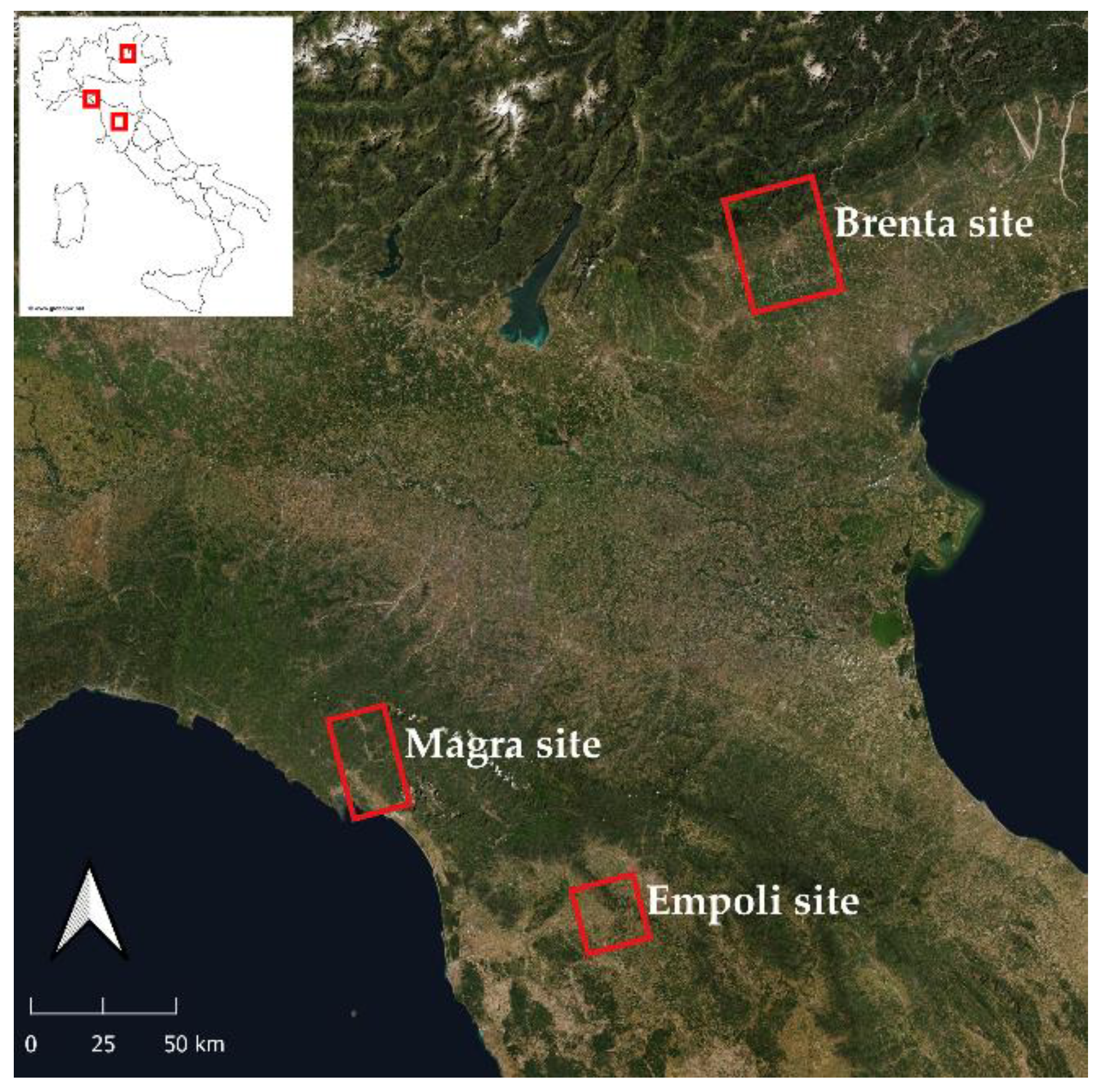

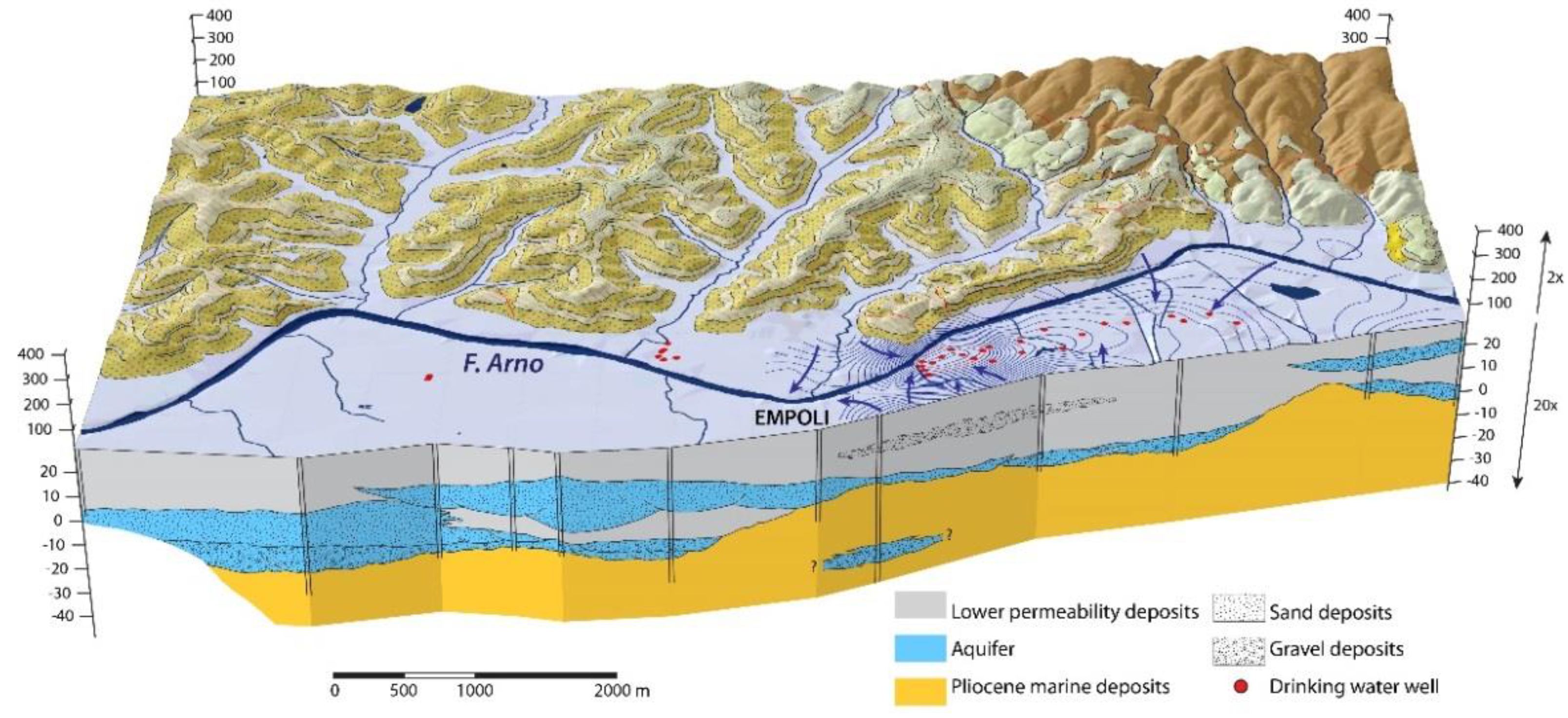
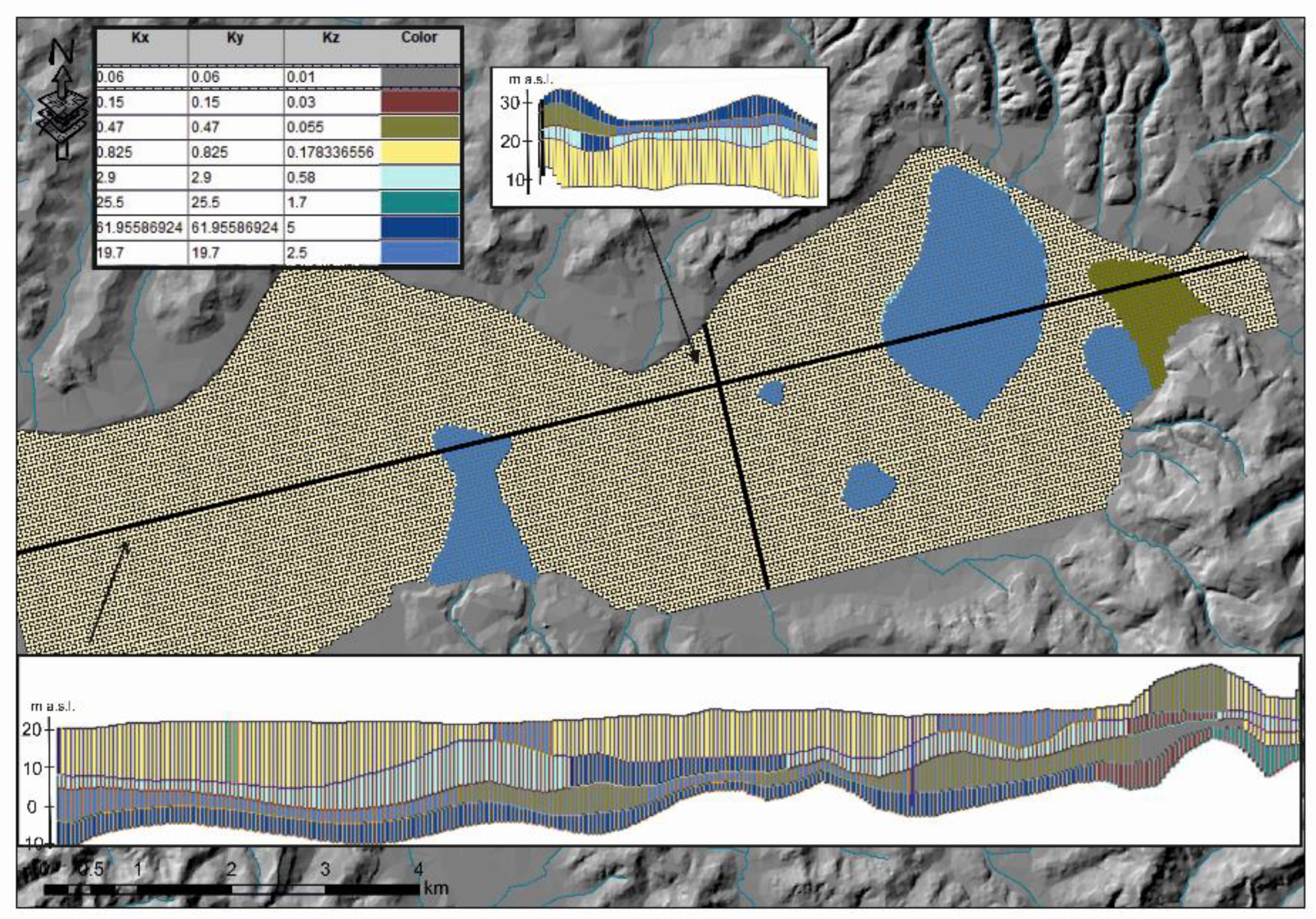

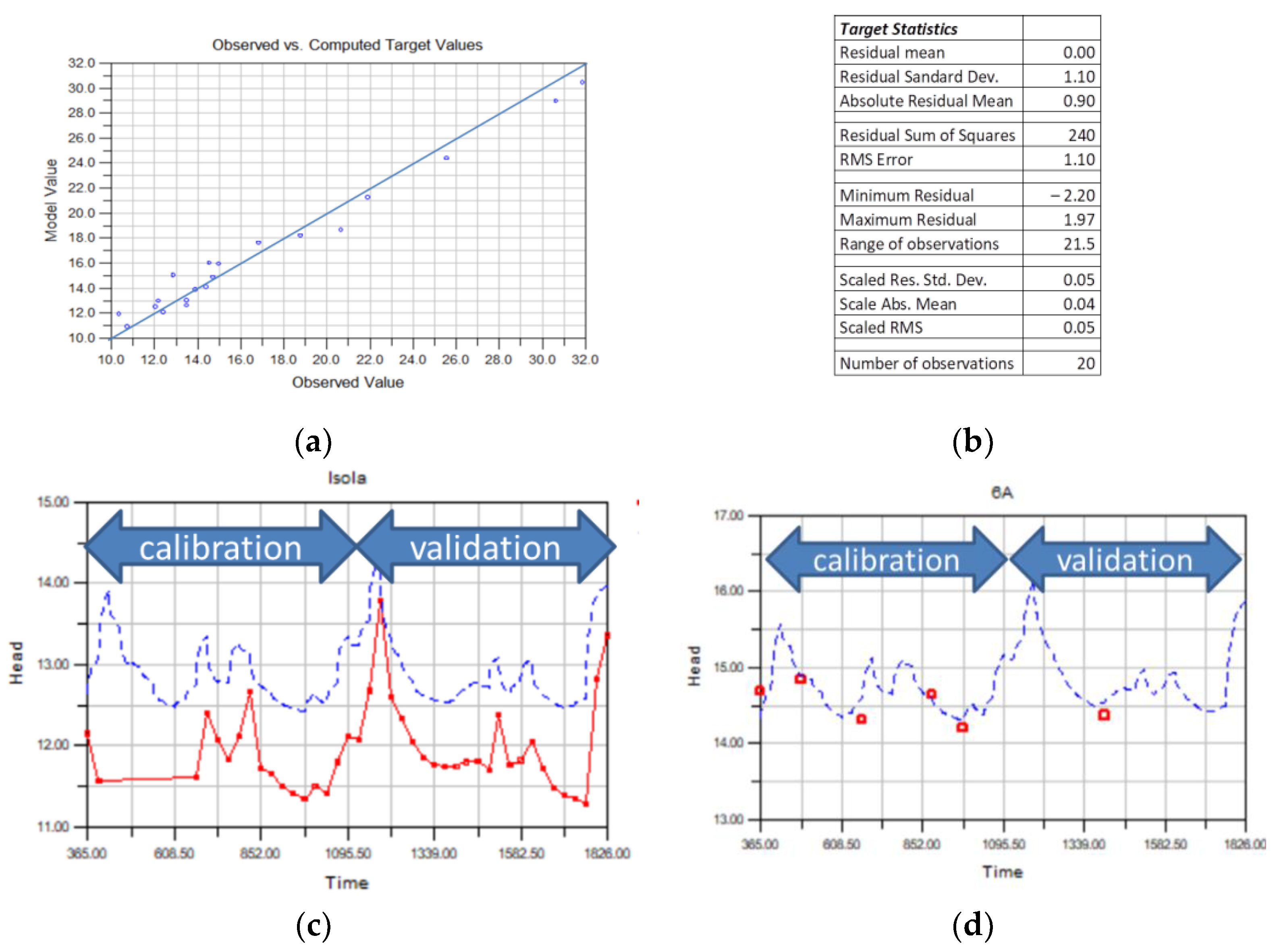
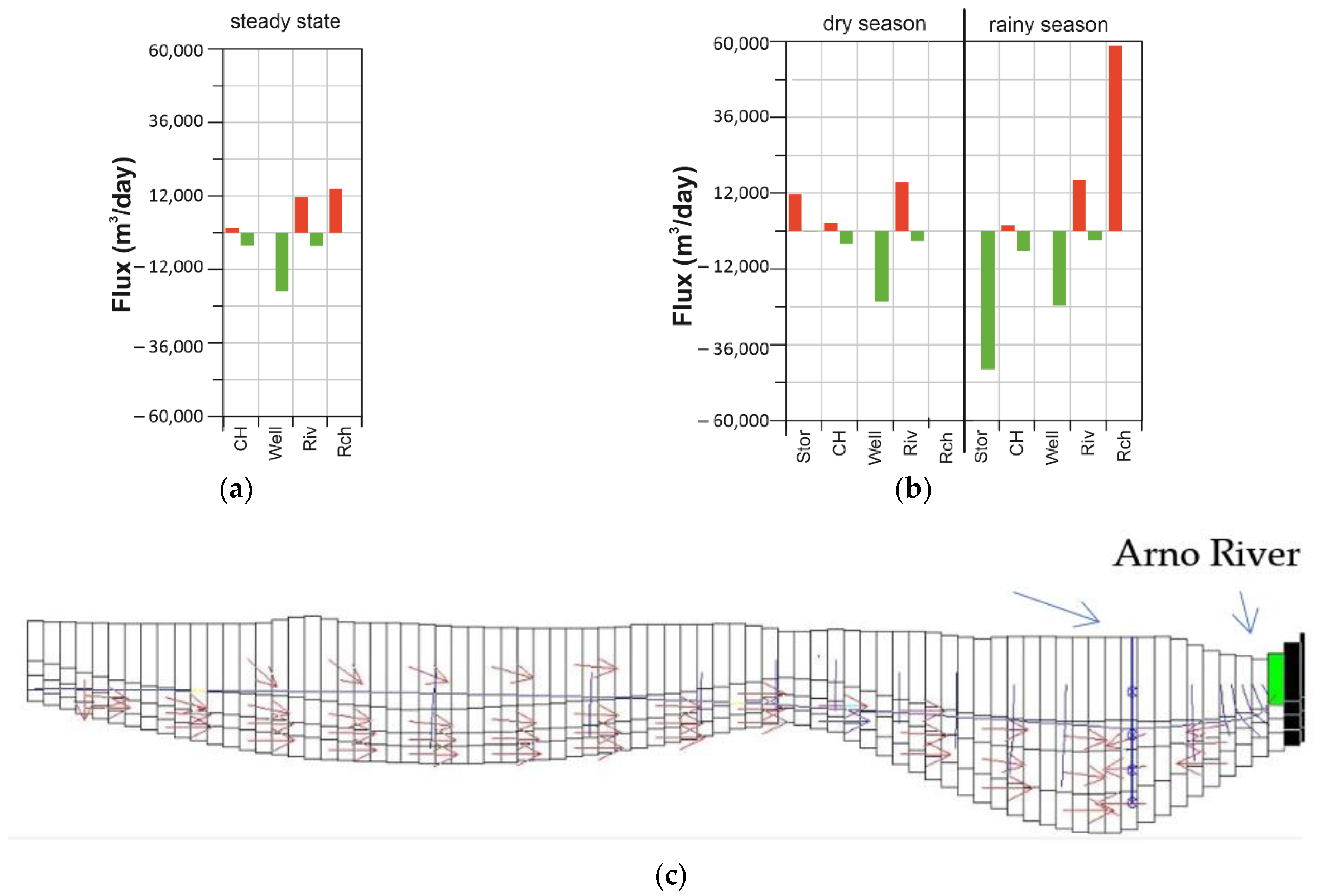


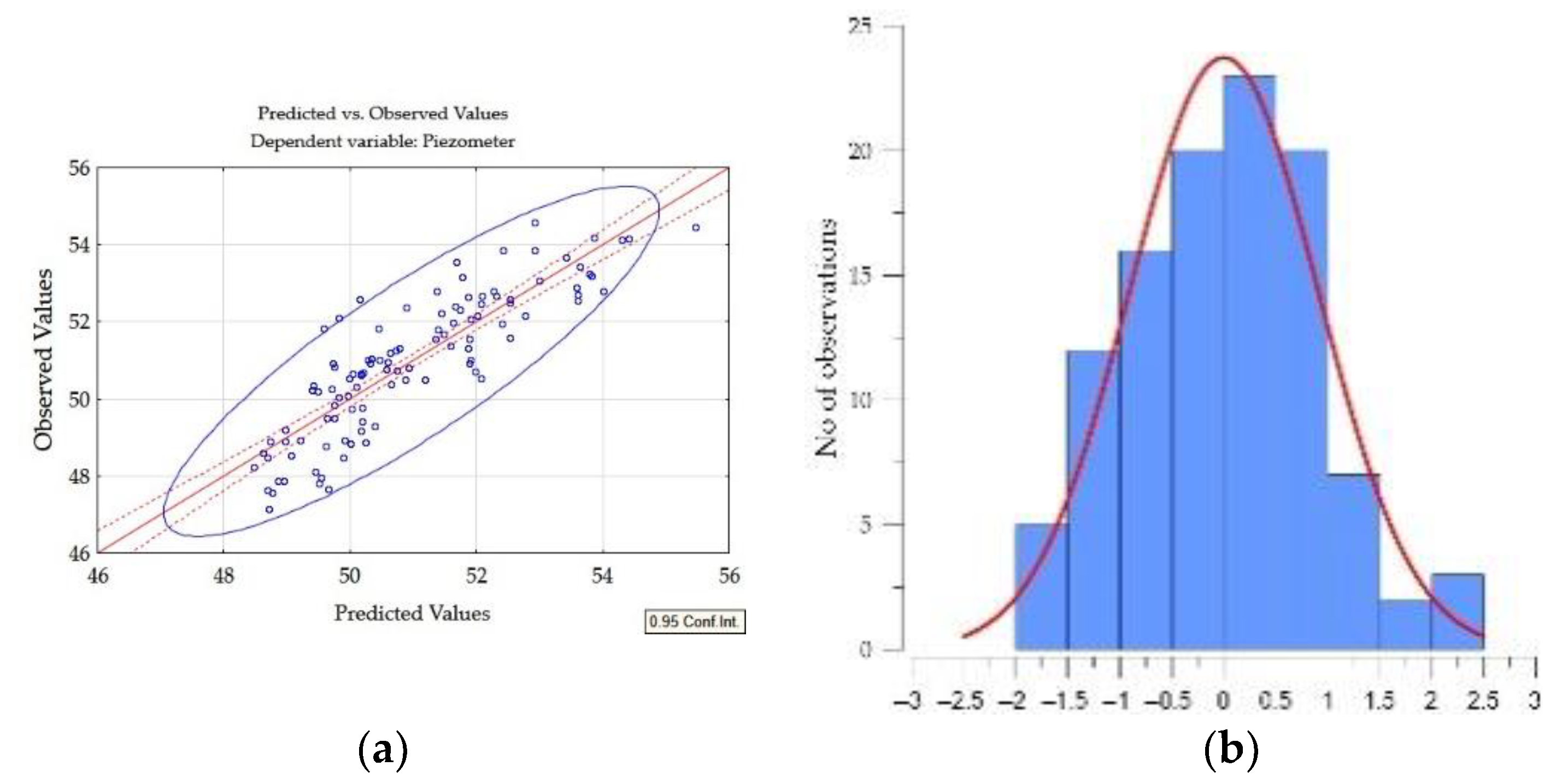


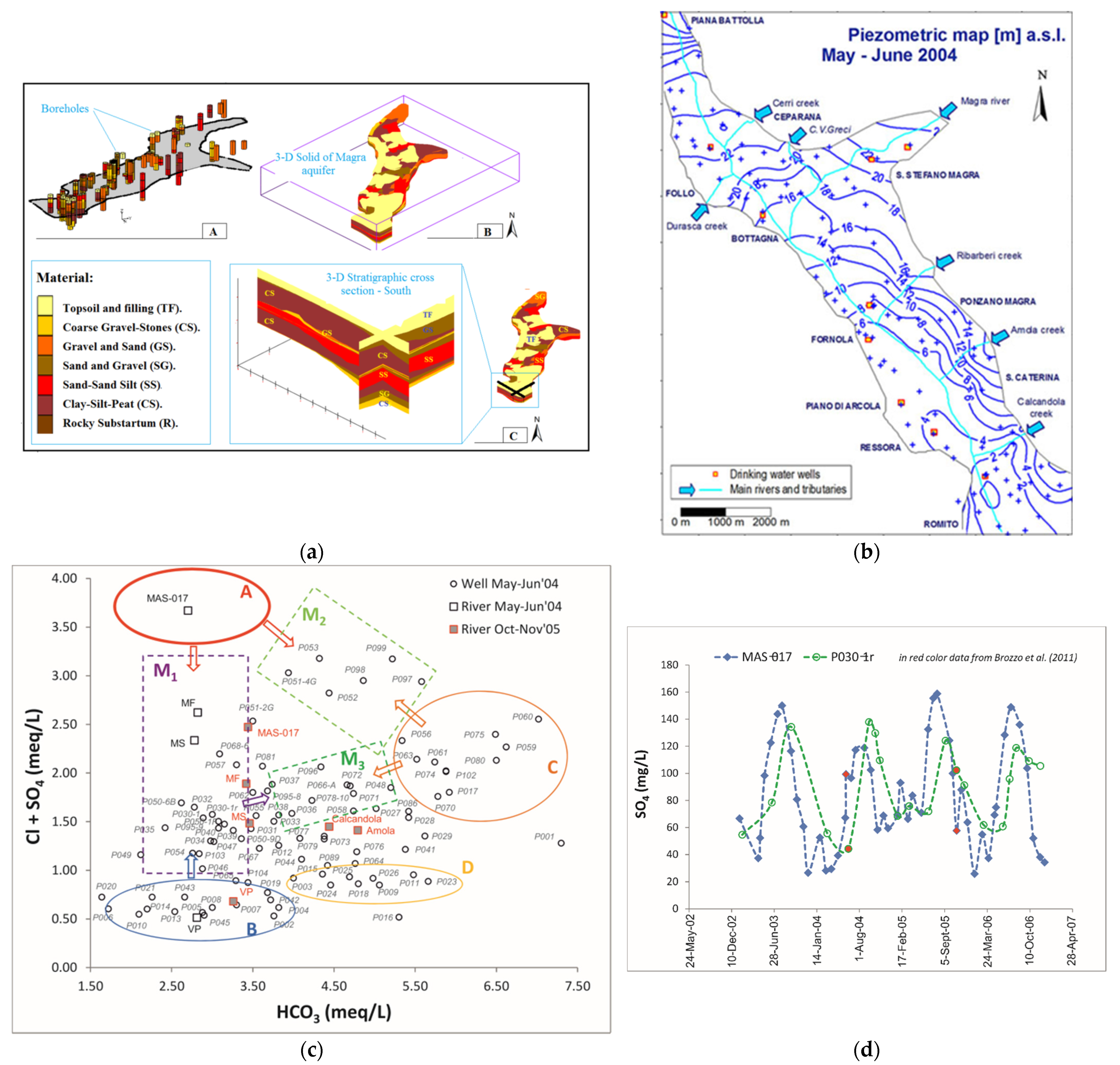




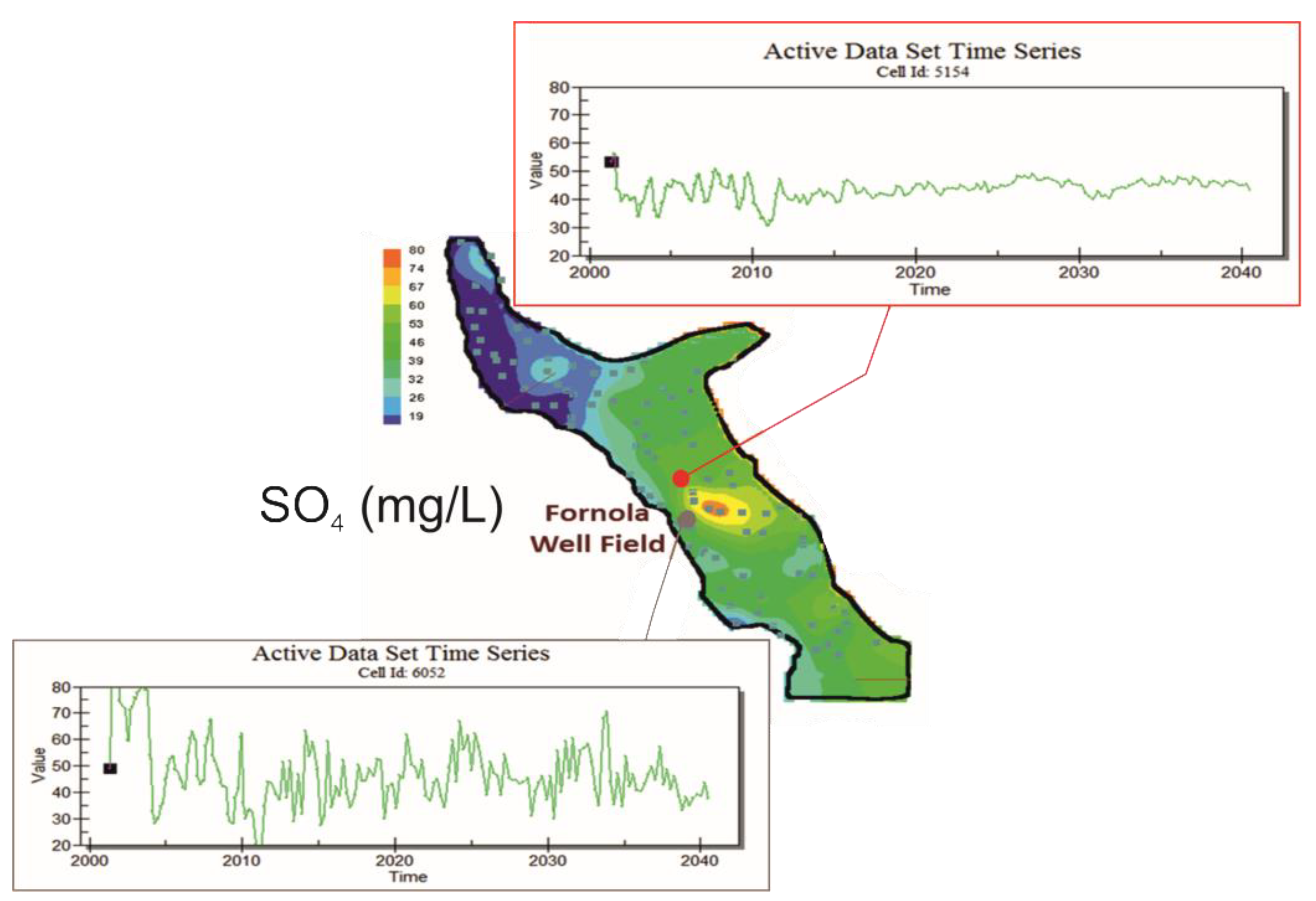
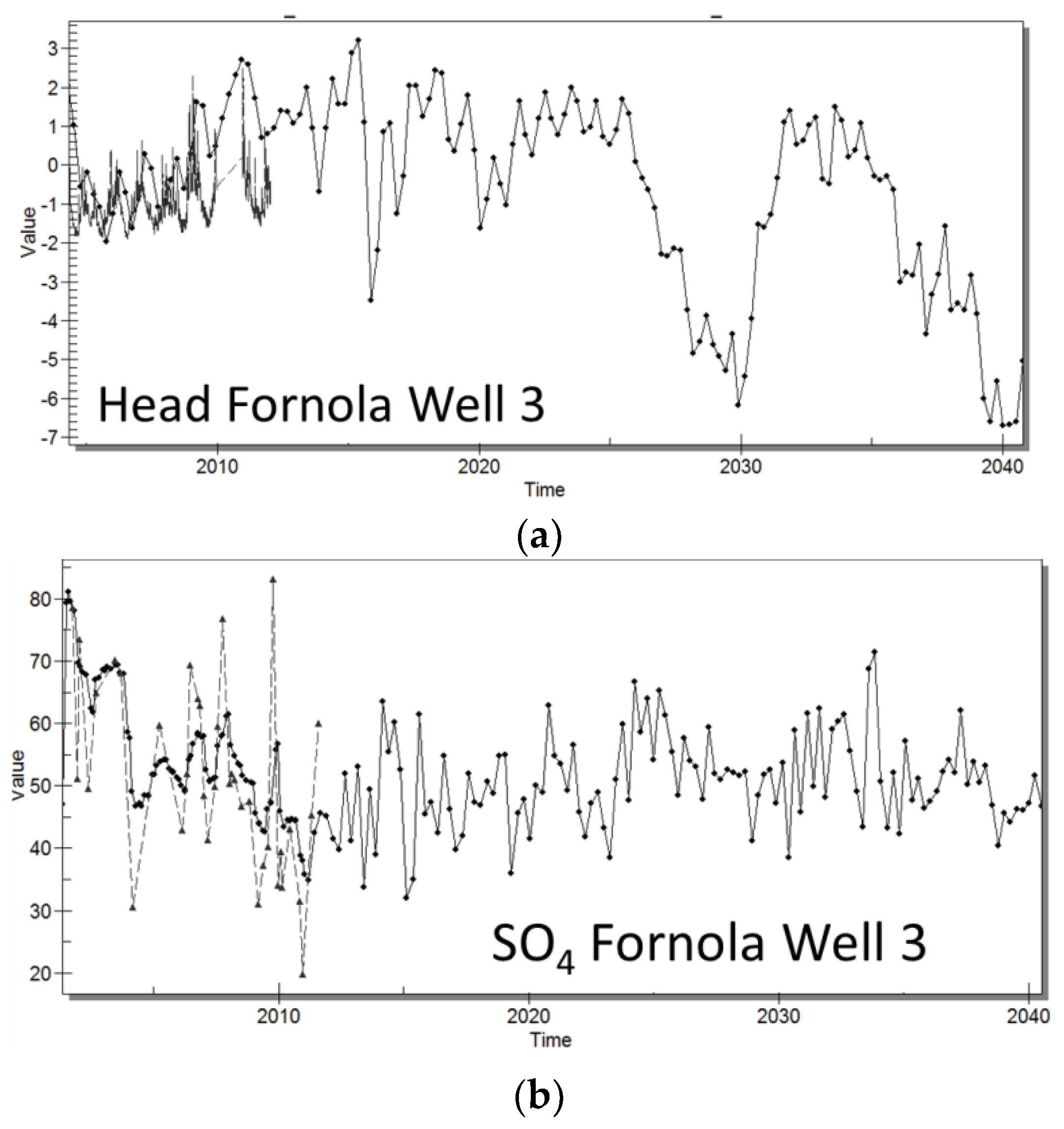
| Water Consumption (Mm3) | Use |
|---|---|
| 8 | Drinkable |
| 0.2 | Domestic |
| 2.2 | Industrial |
| 0.5 | Agricultural |
Publisher’s Note: MDPI stays neutral with regard to jurisdictional claims in published maps and institutional affiliations. |
© 2022 by the authors. Licensee MDPI, Basel, Switzerland. This article is an open access article distributed under the terms and conditions of the Creative Commons Attribution (CC BY) license (https://creativecommons.org/licenses/by/4.0/).
Share and Cite
Menichini, M.; Franceschi, L.; Raco, B.; Masetti, G.; Scozzari, A.; Doveri, M. Groundwater Modeling with Process-Based and Data-Driven Approaches in the Context of Climate Change. Water 2022, 14, 3956. https://doi.org/10.3390/w14233956
Menichini M, Franceschi L, Raco B, Masetti G, Scozzari A, Doveri M. Groundwater Modeling with Process-Based and Data-Driven Approaches in the Context of Climate Change. Water. 2022; 14(23):3956. https://doi.org/10.3390/w14233956
Chicago/Turabian StyleMenichini, Matia, Linda Franceschi, Brunella Raco, Giulio Masetti, Andrea Scozzari, and Marco Doveri. 2022. "Groundwater Modeling with Process-Based and Data-Driven Approaches in the Context of Climate Change" Water 14, no. 23: 3956. https://doi.org/10.3390/w14233956
APA StyleMenichini, M., Franceschi, L., Raco, B., Masetti, G., Scozzari, A., & Doveri, M. (2022). Groundwater Modeling with Process-Based and Data-Driven Approaches in the Context of Climate Change. Water, 14(23), 3956. https://doi.org/10.3390/w14233956






